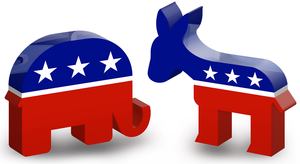DCCC and NRCC drive outside spending in the House

Image credit: Flickr user DonkeyHotey
With most of media attention and special interest dollars in election 2014 have been aimed at competitive Senate races, data from Sunlight’s Real-Time Federal Campaign Finance tracker shows outside spenders have plunked down $120 million trying to influence the outcome of races for the U.S. House. But in this case the biggest spending outsiders are the ultimate insiders: A new Sunlight analysis finds that political party committees are the biggest underwriters of competitive House races.
Using campaign finance data collected by our Real-Time Federal Campaign Finance tracker, we found that the Democratic Congressional Campaign Committee and National Republican Congressional Committee — the major parties’ congressional campaign arms have accounted for nearly half of that total. Expenditure data suggests these two committees drove most of the outside spending we’ve seen so far in House races.
Out of the 442 congressional races (including territories) to be decided in 2014, there are 23 where third-party groups have outspent the campaigns themselves. The DCCC has been active in all of those races while the NRCC has invested in 21. Along with a recurring cast of other outside actors, these two groups pay for ads, mailers and polling in contested races.
Figures below in millions:
So why would two committees that raise much of their funds from “dues” paid by members of Congress via their individual campaign committees be running campaigns “independent” of the candidates they are trying to elect (and in many cases helped recruit)? Because they can spend more that way. Campaign finance law, however, allows party committees to spend unlimited funds in support of a federal candidate, like super PACs, as long as they do not coordinate with the candidate in doing so.
Though the NRCC faced a well-documented fundraising disadvantage this cycle, both committees employed a similar strategy: pouring funds into districts ripe for a partisan flip and races featuring endangered incumbents. These targets aren’t a secret to the outside spenders, and are publicly listed on the committees’ websites and press releases.
The races above generally follow the same pattern, with major party committees leading the way in total spending followed by substantial investments from groups like the House Majority PAC and the U.S. Chamber of Commerce, a 501(c)6 trade group.
House Majority in particular moves in lockstep with the DCCC. Fueled by seven-figure donations from liberal mega-donors like Fred Eychaner and George Marcus and headed by Ali Lapp, who previously served as deputy director of the DCCC’s independent expenditure program, the PAC acts almost like a second arm to the Democrats.
The outliers
Of course there are other, non-party super PACs spending in House races that don’t follow the party or quasi-party model.
Wealthy donors that fund single-issue super PACs can be a major boon to candidates that support friendly policies. Paul Singer, the hedge fund manager, Republican super PAC donor and gay rights activist, has made major investments through his American Unity PAC for Republican candidates that have expressed support for gay marriage.
Likewise, as Sunlight detailed last week, a trio of congressional candidates — two sitting incumbents and a newcomer — each saw $700,000 spent on their behalf by the National Association of Realtors Congressional Fund on account of their support for pet issues like protecting the Mortgage Interest Deduction and the National Flood Insurance Fund.
You can see all the spending details of every congressional race on Real-Time.

